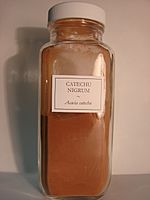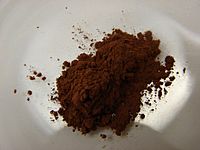Catechu facts for kids
Catechu is a special extract made from acacia trees. People use it for many things, like a food ingredient, a substance that tightens tissues (called an astringent), a tannin (used to treat leather), and a dye. It's made by boiling the wood of certain Acacia trees, especially the Senegalia catechu tree, in water. Then, the water is evaporated, leaving behind the extract.
Catechu is also known by other names such as cutch, black cutch, cachou, terra Japonica, or Japan earth. In different languages, it's called katha (Hindi), kaath (Marathi), khaira (Odia), khoyer (Assamese and Bengali), and kachu (Malay). The name Acacia catechu comes from the Malay word "kachu."
Contents
How Catechu is Used
Catechu has been used for a very long time in traditional medicine, like Ayurveda in India. It acts as an astringent, which means it can help shrink or tighten body tissues.
In Food and Breath Fresheners
You might find catechu in some breath-freshening sweets, like certain licorice pastilles in France and Italy. It's also a key ingredient in paan mixtures, which are popular in South Asia. Paan is a traditional chew made from betel leaf and other ingredients.
For Tanning Leather
Catechu is rich in natural plant substances called tannins. These tannins are what give catechu its astringent effect. Because of this, catechu can be used to tan animal hides. Tanning is a process that turns animal skins into leather, making them strong and preventing them from rotting. In the early 1800s, a scientist named Humphry Davy showed that catechu could be used for tanning instead of more expensive materials like oak extracts.
As a Dye
Under the name cutch, catechu is a brown dye. It's used to color fabrics like wool, silk, and cotton a yellowish-brown. It can also be used to preserve fishing nets and sails, making them last longer. When used with an iron mordant (a substance that helps the dye stick), cutch gives gray-brown colors. With a copper mordant, it creates olive-brown shades.
Catechu has even been used to color some drinks, like a type of black vodka.
Other Types of Catechu
There are other types of catechu too. White cutch, also called gambier or gambir, comes from a different plant called Uncaria gambir. It has similar uses to black catechu. Another type, palm-catechu, is made from the seeds of the Areca catechu palm tree.
See also
 In Spanish: Catecú para niños
In Spanish: Catecú para niños




